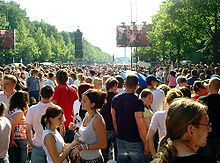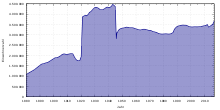Berlin population statistics
Berlin is the most populous city in the European Union, as calculated by city-proper population (not metropolitan area).
Demographics
Population by borough


Historical development of Berlin's population

|
|
|
The spike in population in 1920 is a result of the Greater Berlin Act.
Population by nationality
On 31 December 2010 the largest groups by foreign nationality were citizens from Turkey (104,556), Poland (40,988), Serbia (19,230), Italy (15,842), Russia (15,332), United States (12,733), France (13,262), Vietnam (13,199), Croatia (10,104), Bosnia and Herzegovina (10,198), UK (10,191), Greece (9,301), Austria (9,246), Ukraine (8,324), Lebanon (7,078), Spain (7,670), Bulgaria (9,988), the People's Republic of China (5,632), Thailand (5,037).[1] There is also a large Arabic community, mostly from Lebanon, Palestine and Iraq. Additionally, Berlin has one of the largest Vietnamese communities outside Vietnam, with about 83,000 people of Vietnamese origin.[2]
| Country of origin | Population |
|---|---|
| 2,525,000 [3] | |
| Est. 300,000[4][5] | |
| 250,000–300,000[6] (see: Turks in Berlin) | |
| Est. 300,000- 340.000[7] | |
| Est. 83,000[8] | |
| Est. 70,000[9] (see: Arabs in Berlin) | |
| Est. 20,000 (estimations vary from 15,000-25,000). Actually there are about 1,800 Ghanaian citizens residing in Berlin, however, there are many Germans of Ghanaian and other West-African origin or with one parent being German and the other being from Ghana.[10] | |
| Almost or at least 20,000[11] |
See also
References
- ^ "Archived copy" (PDF). Archived from the original (PDF) on 2011-07-19. Retrieved 2011-02-05.
{{cite web}}: CS1 maint: archived copy as title (link) - ^ "The Asia Pacific Times Online - Little Hanoi". Asia-pacific-times.com. Archived from the original on 2012-03-14. Retrieved 2013-02-10.
- ^ "Share of Germans without "migrational background"". Berliner Morgenpost. Retrieved 2015-11-26.
- ^ "Sie lieben Berlin und schwärmen von Russland | Zeit Online". zeit.de. 2014-04-16. Retrieved 2016-10-25.
- ^ "Russen in Berlin – Wie stehen sie zu Präsident Putin? | Berliner Morgenpost". morgenpost.de. 2014-05-13. Retrieved 2016-10-25.
- ^ "General information about Berlin". Havetravelfun.com. Retrieved 2013-02-10.
- ^ von Daniela Martens (2010-04-18). "Polen in Berlin: Unter Nachbarn - Berlin - Tagesspiegel" (in German). Tagesspiegel.de. Retrieved 2013-02-10.
- ^ "The Asia Pacific Times Online - Little Hanoi". Asia-pacific-times.com. Archived from the original on 2011-07-07. Retrieved 2016-10-25.
{{cite web}}: CS1 maint: bot: original URL status unknown (link) - ^ "Archived copy" (PDF). Archived from the original (PDF) on 2013-09-21. Retrieved 2009-09-05.
{{cite web}}: CS1 maint: archived copy as title (link) - ^ "Archived copy" (PDF). Archived from the original (PDF) on 2014-02-03. Retrieved 2014-08-17.
{{cite web}}: CS1 maint: archived copy as title (link) - ^ "US-Wahlparty: Exil-Amerikaner in Berlin wählen Obama und McCain - SPIEGEL ONLINE". Spiegel.de. Retrieved 2013-02-10.
External links
- Berlin State Statistical Office
- Berlin State Statistical Office (old homepage)
- Schwenk, Herbert, Berliner Stadtentwicklung von A bis Z: Kleines Handbuch zum Werden und Wachsen der deutschen Hauptstadt, 2nd edition. Berlin: Luisenstädtischer Bildungsverein, 1998.
